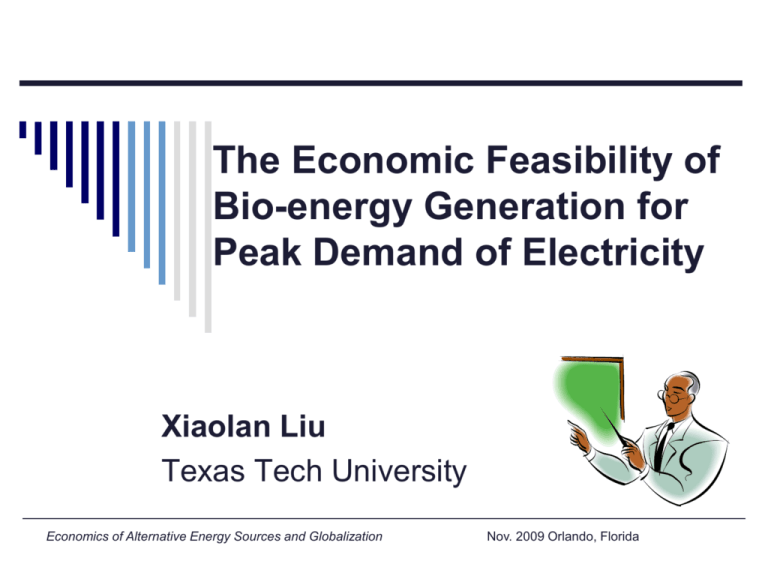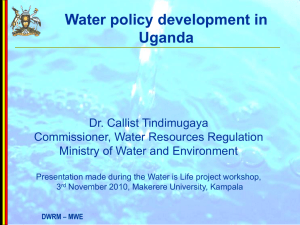Presentation
advertisement

The Economic Feasibility of Bio-energy Generation for Peak Demand of Electricity Xiaolan Liu Texas Tech University Economics of Alternative Energy Sources and Globalization Nov. 2009 Orlando, Florida The Economic Feasibility of Bio-energy Generation for Electricity at Peak Demand Introduction and Problem statement Study Objectives Methods and Procedures Model Development and Results Conclusions I. Introduction and Problem statement On average, 1,570,000 tons of cotton gin waste (CGW) is produced; approximately equals to 4,791 million kwh of electricity annually; Compare to the national structure, the market demand for bio-fuel in Texas is more pronounced at industry sector, which account for 72% of total biomass energy consumption; Strong intents exist to obtain bio-energy from biomass at Texas. Regional Concentration of Texas Cotton Planting (Source: USDA/TASS) I. Introduction and Problem statement Because of the natural of agricultural waste, the idea of converting it to bio-fuels faces a long-standing difficulty of commercialization: (cont.) unstable supply (dependents on weather and crop market price); limited scale and low efficiency; relative higher costs of biomass transport and conversion facilities. As a result, the usually low selling price and unstable profits of bio-energy production restrict its scale, and lead some undesirable features for many investors. II. Study Objectives The overall objective is to analyze economic feasibility of electricity generation from CGW for peak load demand. Four specific objectives: establish the appropriate area, locations and collectable volume of CGW; Estimate the variability and distribution of CGW; Determine the economic models for optimal production scales; Conduct relative economic analysis: sensitivity analysis, cost/benefit analysis, rate of return, risk analysis etc. III. Methods and Procedures Grouped CGW Based on cotton production and maps of GIS, the locations and volumes of CGW for each gin are identified: 79 gins from 16 counties with total average of CGW around 850,000 tons annually; CGW from ginners are grouped within 10 miles radius area from a possible location of a bioenergy plant based on the closest rule. 19 groups are identified, and 13 of them with average CGW above 20,000 tons annually. Locations of Gins and selected groups J E B L F Q G C M H I N Alternative Technologies and Possible Scenarios Mobile END III. Methods and Procedures (cont.) Variations and distribution of CGW supply Variation is an un-ignorable feature of crop residues, and is important to determine the possible firm scales and related risk and costs; The main factors related the variation of CGW supply are weather and cotton price because not only market risk exists, but also cotton production is heavily influenced by the incidence of dry weather in study region; MCMC method was used to estimate the parameters. With specified joint distribution, values of the unknown parameters from their conditional (posterior) distribution are sampled given those stochastic nodes that have been observed. III. Methods and Procedures (cont.) Economic Models for Optimal Scale Rational producers are assumed to maximize profit given their limited resources and available inputs and opportunities; With the estimated PDF of CGW, expected profits could be obtained for bio-energy outputs given fixed cost, possible transportation costs and variable costs for labor, storage and other operating costs. BACK IV. Model Development and Results Model for Estimating CGW Distribution Table 1. Estimated Results of MCMC Model Node mean b[1] 2.576 b[2] 4.257 b[3] -0.5866 b[4] 0.668 tau 12.95 sd 6.029 3.295 0.5413 0.5919 9.774 MC error 0.02035 0.01108 0.001818 0.001962 0.05568 2.5% median 97.5% -9.562 2.605 14.56 -2.36 4.269 10.84 -1.669 -0.5888 0.5039 -0.5 0.6565 1.894 1.525 10.49 38.17 start 501 501 501 501 501 sample 88500 88500 88500 88500 88500 Mean (63) Optimal Point (76) END IV. Model Development and Results (cont.) Economic Model for Profit Maximization Summary of Assumptions Sale prices of electricity at MWP, MWSP, OWN and IC are $120, $65, $45, and $30 per MWe; Establishment expense: gasification $ 2.8 MM/Mwe ($185,000 /MWe annually); Variable cost is $5.5 per MWe generated; Supplement (penalty) cost is $140 per MWe; Transportation cost is $20 per ton of CGW; 50% of total electricity OWN needs can be provided by the process of bio-energy production. Results of Economic Model for Gasification Performance Distributions of Economic Models Performance Distribution of Model 1 Prob Mwe IC OWN Surpl. VC Revenue Profits 0.05 68350 41984 7374 0 $ 375,925 $ 3,333,318 $ 1,151,053 0.05 68350 42699 6659 0 $ 375,925 $ 3,322,593 $ 1,140,328 0.15 68350 43089 6269 0 $ 375,925 $ 3,316,741 $ 1,134,476 0.25 68350 43673 5686 0 $ 375,925 $ 3,307,988 $ 1,125,723 0.25 55780 32148 4640 0 $ 306,790 $ 2,915,203 $ 802,073 0.15 42185 19684 3509 0 $ 232,018 $ 2,490,390 $ 452,032 0.05 34870 12978 2901 0 $ 191,785 $ 2,261,812 $ 263,687 0.05 20330 0 1338 0 $ 111,815 $ 1,802,179 $ -115,976 Performance Distribution of Model 2 Prob Mwe IC OWN Trans. VC Revenue Profits 0.05 68350 41984 7374 0 $ 375,925 $ 3,333,318 $ 1,151,053 0.05 68350 42699 6659 0 $ 375,925 $ 3,322,593 $ 1,140,328 0.15 68350 43089 6269 0 $ 375,925 $ 3,316,741 $ 1,134,476 0.25 68350 43673 5686 2.00E-03 $ 375,925 $ 3,307,988 $ 1,125,723 0.25 68350 44718 4640 12570 $ 375,925 $ 3,292,304 $ 1,097,469 0.15 68350 45849 3509 26165 $ 375,925 $ 3,275,340 $ 1,066,910 0.05 68350 46458 2901 33480 $ 375,925 $ 3,266,212 $ 1,050,467 0.05 68350 47667 1691 48020 $ 375,925 $ 3,248,070 $ 1,017,785 Model1 Model2 Expected Profits $ 841,827 $ MWP (Mwe/yr) 9227.3 MWSP (Mwe/yr) 9764.3 FC $ 1,806,393 $ HOUR (hour/yr) 7000 Capacity (Mwe/hr) 9.76 Note: Model1 with Penalty term, Model2 with Transportation term. 882,917 9227.3 9764.3 1,806,393 7000 9.76 BACK Model Sensitivity Analysis Dual Price (shadow price, $/unit): the amount of E(π) would improve as the constraints are increased by one unit. Hour 92.6; MWP 89.3; MWSP 34.3 Ranges of Objective Coefficient MWP [100, 145]; MWSP [46, 89] FC [-1.1045, -0.8728] Changes of Electricity Supply (Mwe/yr): how far either increasing or decreasing the amount of outputs without changing its dual price. Current MWP 9227 MWSP 9764 ↑ 1338 1338 ↓ 353 353 Optimal Results of Selected Groups Optimal Results of Economic Models for Selected Groups ($/year, MWe/year) Group G Expected Profits $ Production Capacity 935,115 Group M $ 841,827 Group L $ 573,571 Group R $ 262,523 Sum $ 6,327,150 75,925 68,350 46,575 21,315 514,360 MWP 10,250 9,227 6,288 2,878 69,439 MWSP 10,846 9,764 6,654 3,045 73,480 $ 1,806,393 $ 1,230,911 Fixed Cost $ 2,006,589 $ 563,325 $ 13,593,800 HOUR (hour/yr) 7000 7000 7000 7000 7000 Plant Scale 10.85 9.76 6.65 3.05 73.48 Average CGW (ton) 74,501 67,067 45,698 20,914 504,702 Note: Sum is the aggregation of 13 groups with average CGW above 20,000 tons annually. Results of Economic Model for Bio-oil/Power Generation Income Statement of Standalone 100 tpd Bio-oil Plant Net Sale Bio-oil Char Others Total Sales Cost of Goods Sold Labor & Overhead Transport Cost Electricity Consumables Maintenance Total CGS Gross Profit/Loss Operating Expenses SG&A Cost of Money Property Tax Total Operating Expense $ $ 4,547,510 263,670 $ $ $ $ $ $ 561,700 27,720 558,000 240,559 280,000 1,667,979 3,143,201 131,160 491,880 168,000 Net Profit / Loss Break Even Bio-oil Price 20% ROI Bio-oil Price Assumptions: Bio-oil Sale Price Char Sale Price Transportation Cost 23% 1% 23% 10% 11% $ $ $ $ $ 4,811,180 5% 20% 7% $ 791,040 $ $ 2,352,161 0.59 $ 1.22 47 0.14 ROI 96% 0.72 $/gal $/ton $/ton/mile, BACK Results of Economic Model for Biooil / Electric Power Generation (cont.) Gas turbine-based CHP system $0.86 MM / MWh of fixed costs, $4.9 / MWh variable costs and $25 / ton federal subsidy negative profits obtained for the process from bio-oil to electricity; 50% lower cost of boiler and $ 25 / ton federal subsidy electricity production is barely operated at $120/MW. V. Conclusions Locations and collectable volume of biomass are successfully established; The estimated variability distribution of CGW is reasonable for addressing risk in the process of bioenergy production; Grouped gasification with certain plant scale is a profitable way to generate electricity for peak load needs, self consumption and incidental sale; Bio-oil processing seems profitable, but capital intensity for power plants leads economic unviable for electricity generation from bio-oil in the study region.









